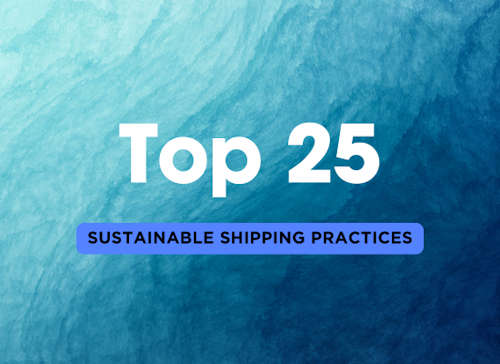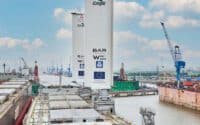Top 25 Sustainable Maritime Shipping Practices
September 25, 2024

The maritime industry is taking significant steps to reduce its environmental footprint and combat climate change. As global shipping accounts for nearly 3% of the world's carbon emissions, implementing sustainable practices is crucial for the industry's future. From adopting new green technologies to optimizing operational efficiency, these changes not only reduce emissions but also create more cost-effective operations for shipowners.

1. Slow Steaming 🐢
- What it is: Slow steaming involves reducing a ship's speed to optimize fuel consumption and lower emissions. By operating at lower speeds, vessels can achieve significant fuel savings.
- Benefits:
- Reduces fuel consumption by up to 30%.
- Lowers CO₂ emissions and other pollutants.
- Prolongs the lifespan of engines and equipment.
2. Air Lubrication Systems 🌬️
- What it is: Air lubrication technology reduces the friction between a ship’s hull and the water by creating a layer of air bubbles. This reduces drag and fuel consumption.
- Benefits:
- Can reduce fuel consumption by 10-15%.
- Improves the overall energy efficiency of vessels.
- Works on various types of ships, including bulk carriers and tankers.
3. LNG as an Alternative Fuel 🔥
- What it is: Liquefied Natural Gas (LNG) is a cleaner alternative to traditional marine fuels like heavy fuel oil (HFO). LNG significantly reduces sulfur, nitrogen oxides (NOx), and carbon emissions.
- Benefits:
- Reduces CO₂ emissions by up to 20%.
- Virtually eliminates sulfur oxides (SOx) and particulate matter emissions.
- LNG infrastructure is expanding globally, making it a viable long-term solution.
4. Wind-Assisted Propulsion ⛵
- What it is: Wind-assisted technologies, such as rotor sails and rigid sails, use wind power to complement the ship’s propulsion system, reducing fuel consumption.
- Benefits:
- Can reduce fuel consumption by 5-20%, depending on wind conditions.
- Works well on long-haul routes with consistent wind patterns.
- Minimizes reliance on fossil fuels, offering immediate environmental benefits.
5. Shore Power (Cold Ironing) ⚡
- What it is: Shore power, or cold ironing, allows ships to plug into onshore electricity while at port, eliminating the need to keep their engines running for power.
- Benefits:
- Reduces fuel consumption and emissions while at berth.
- Cuts down CO₂, NOx, and SOx emissions at ports by up to 90%.
- Improves air quality in and around busy ports, benefiting local communities.
6. Ballast Water Treatment Systems 💧
- What it is: Ballast water treatment systems prevent the spread of invasive species by treating ballast water before it's discharged. This is crucial for protecting marine ecosystems.
- Benefits:
- Complies with international regulations (e.g., IMO Ballast Water Management Convention).
- Reduces the risk of invasive species spreading and damaging marine ecosystems.
- Minimizes environmental fines and penalties for non-compliance.
7. Hybrid Electric Propulsion Systems ⚡
- What it is: Hybrid electric propulsion systems combine traditional marine engines with electric power to reduce fuel consumption and emissions during certain phases of a voyage, such as when entering ports or navigating inland waterways.
- Benefits:
- Reduces fuel consumption by up to 20% during low-speed operations.
- Lowers emissions, especially in emission control areas (ECAs).
- Offers flexible power management, enhancing efficiency.
8. Biofuels 🌱
- What it is: Biofuels, derived from organic materials like plant oils or waste, offer a cleaner alternative to fossil fuels. They can be used in existing engines with minimal modifications.
- Benefits:
- Reduces greenhouse gas emissions by up to 90%, depending on the type of biofuel used.
- Provides a renewable fuel option, reducing reliance on fossil fuels.
- Helps meet carbon reduction targets in the shipping industry.
9. Energy-Efficient Ship Designs 🚢
- What it is: New ship designs, including optimized hull shapes and lightweight materials, reduce drag and improve fuel efficiency. Incorporating these designs during the construction of new vessels leads to significant long-term energy savings.
- Benefits:
- Reduces fuel consumption by 10-20%.
- Decreases operational costs due to lower energy requirements.
- Contributes to achieving long-term emission reduction targets.
10. Solar Panels for Auxiliary Power ☀️
- What it is: Solar panels installed on ships can be used to generate power for auxiliary systems, reducing the load on the main engine and fuel consumption.
- Benefits:
- Reduces fuel consumption for auxiliary systems by up to 5%.
- Provides a renewable source of energy, cutting emissions.
- Works well in combination with other renewable technologies like wind-assisted propulsion.
11. Exhaust Gas Cleaning Systems (Scrubbers) 🧼
- What it is: Scrubbers remove sulfur oxides (SOx) from the exhaust gases of ships, allowing vessels to meet international emissions regulations while continuing to use traditional fuels like heavy fuel oil (HFO).
- Benefits:
- Reduces sulfur emissions by up to 98%, making ships compliant with IMO 2020 regulations.
- Allows continued use of lower-cost traditional fuels while reducing environmental impact.
- Helps avoid fines and penalties in emissions control areas (ECAs).
12. Fuel Cell Technology 🔋
- What it is: Fuel cells convert hydrogen or other fuels directly into electricity, offering a highly efficient and emission-free power source for ships. This emerging technology could revolutionize shipping energy systems.
- Benefits:
- Emits zero harmful pollutants like CO₂, NOx, or SOx.
- Offers high energy efficiency, with the potential to replace conventional engines in the future.
- Fuel cells are scalable, meaning they can power both small auxiliary systems and full ship propulsion.
13. LED Lighting on Vessels 💡
- What it is: Replacing traditional lighting with energy-efficient LED lighting throughout ships reduces the energy load on generators and engines, cutting down on fuel consumption.
- Benefits:
- Uses up to 80% less energy than conventional lighting systems.
- Reduces fuel consumption and operating costs.
- Longer lifespan than traditional bulbs, reducing maintenance needs.
14. Just-In-Time Arrival ⏱️
- What it is: Just-in-time arrival strategies involve optimizing arrival schedules to reduce time spent idling outside ports, which cuts fuel consumption and emissions. Ships adjust speed during the journey to match the most efficient port arrival time.
- Benefits:
- Reduces fuel consumption by avoiding unnecessary idling outside ports.
- Lowers emissions during the approach to ports.
- Improves coordination with port operations, reducing congestion and delays.
15. Advanced Waste Heat Recovery Systems ♻️
- What it is: Waste heat recovery systems capture excess heat from a ship's engine and repurpose it to generate electricity or heat, improving overall energy efficiency.
- Benefits:
- Reduces fuel consumption by using waste energy that would otherwise be lost.
- Increases overall energy efficiency by up to 8%.
- Lowers operating costs by reducing reliance on fuel-powered generators.
16. Onboard Water Treatment and Recycling Systems 🚰
- What it is: These systems treat and recycle wastewater generated onboard, reducing the need for fresh water and minimizing pollution discharged into the ocean.
- Benefits:
- Lowers the ship’s environmental impact by minimizing wastewater discharge.
- Reduces the need for water bunkering, lowering operational costs.
- Helps comply with stringent international water discharge regulations.
17. Automated Voyage Optimization 🧭
- What it is: Using AI and data analytics, automated voyage optimization systems analyze weather, currents, and other variables to recommend the most fuel-efficient routes.
- Benefits:
- Reduces fuel consumption by 5-10% by avoiding inefficient routes.
- Lowers emissions through smarter navigation.
- Improves overall fleet efficiency by reducing unnecessary delays and detours.
18. Eco-Friendly Anti-Fouling Hull Coatings 🎨
- What it is: Traditional anti-fouling paints can release harmful chemicals into the ocean. Eco-friendly coatings, made from non-toxic materials, prevent the buildup of barnacles and algae, reducing drag and fuel consumption.
- Benefits:
- Reduces fuel consumption by 5-10% by maintaining a clean hull.
- Protects marine ecosystems by avoiding harmful chemicals.
- Extends the intervals between dry-docking, lowering maintenance costs.
19. Bio-Lubricants 🛢️
- What it is: Bio-lubricants are biodegradable alternatives to traditional petroleum-based lubricants. They reduce environmental contamination and are safer for marine life.
- Benefits:
- Degrades naturally, reducing the risk of pollution in case of spills.
- Reduces the environmental impact of routine maintenance activities.
- Complies with environmental regulations for environmentally acceptable lubricants (EALs).
20. Wind Turbines for Auxiliary Power 🌬️
- What it is: Small wind turbines installed on ships generate renewable electricity to power auxiliary systems, reducing the reliance on fuel-powered generators.
- Benefits:
- Reduces fuel consumption for auxiliary power by up to 5%.
- Provides a renewable energy source with minimal maintenance.
- Works well in conjunction with solar panels for more sustainable energy use.
21. Carbon Capture and Storage (CCS) 🏭
- What it is: Carbon capture and storage technology captures CO₂ emissions from ship exhausts and stores them, preventing their release into the atmosphere. This is a developing solution to significantly reduce the shipping industry's carbon footprint.
- Benefits:
- Can capture up to 90% of CO₂ emissions.
- Helps meet IMO greenhouse gas (GHG) reduction targets.
- Provides long-term solutions for reducing the industry's reliance on carbon offsets.
22. Digital Twin Technology 💻
- What it is: Digital twins create a virtual model of a ship, allowing operators to simulate different operational scenarios and optimize fuel efficiency, maintenance schedules, and environmental performance.
- Benefits:
- Improves energy efficiency through real-time performance monitoring and predictive maintenance.
- Reduces downtime and fuel consumption by simulating optimal routes and speeds.
- Enables data-driven decisions to lower overall emissions.
23. High-Efficiency Engines 🚢
- What it is: Modern, high-efficiency engines are designed to use less fuel while producing fewer emissions. They are often paired with other sustainable technologies, such as hybrid propulsion and waste heat recovery systems.
- Benefits:
- Reduces fuel consumption by up to 15%.
- Lowers CO₂, NOx, and SOx emissions, helping fleets meet international emissions standards.
- Extends engine life and reduces maintenance costs due to improved operational efficiency.
24. Hydrogen Fuel 🔋
- What it is: Hydrogen fuel is a clean, renewable energy source that produces no carbon emissions when burned. While still in its early stages for maritime applications, it holds promise as a future fuel for ships.
- Benefits:
- Produces zero carbon emissions, helping achieve full decarbonization in shipping.
- Hydrogen can be produced using renewable energy sources, making it a sustainable fuel option.
- Potential to reduce reliance on fossil fuels in the long term.
25. Green Ports Initiatives 🌱
- What it is: Many ports are adopting green initiatives, including electrified docks, zero-emission equipment, and waste recycling programs, to support sustainable shipping practices. Ships that comply with green port standards may receive reduced port fees or faster berthing times.
- Benefits:
- Reduces emissions during port operations by using shore power and other clean technologies.
- Incentivizes ships to adopt sustainable practices through reduced fees.
- Improves overall environmental impact in port cities and regions.
Table Summary
| ShipUniverse: Top 25 Sustainable Shipping Practices | ||
| Practice | What It Is | Benefits |
| Slow Steaming | Reducing ship speed to optimize fuel consumption and lower emissions. | Reduces fuel consumption by up to 30%, lowers CO₂ emissions, and prolongs engine lifespan. |
| Air Lubrication Systems | Using air bubbles to reduce drag between the hull and water. | Reduces fuel consumption by 10-15% and improves overall energy efficiency. |
| LNG as an Alternative Fuel | Switching to Liquefied Natural Gas (LNG) to lower emissions. | Reduces CO₂ emissions by up to 20% and eliminates SOx and particulate matter emissions. |
| Wind-Assisted Propulsion | Using wind power with rotor or rigid sails to reduce fuel use. | Reduces fuel consumption by 5-20% depending on wind conditions. |
| Shore Power (Cold Ironing) | Allowing ships to plug into onshore electricity while at port. | Reduces emissions at port by up to 90% and improves local air quality. |
| Ballast Water Treatment Systems | Systems that treat ballast water to prevent invasive species. | Protects marine ecosystems and complies with international regulations. |
| Hybrid Electric Propulsion Systems | Combining traditional engines with electric power to save fuel. | Reduces fuel consumption by up to 20% during low-speed operations. |
| Biofuels | Using renewable fuels derived from organic materials. | Reduces greenhouse gas emissions by up to 90% and lowers reliance on fossil fuels. |
| Energy-Efficient Ship Designs | Optimized hull shapes and lightweight materials to reduce drag. | Reduces fuel consumption by 10-20% and cuts operational costs. |
| Solar Panels for Auxiliary Power | Using solar panels to power auxiliary systems on ships. | Reduces auxiliary fuel consumption by up to 5%, providing renewable energy. |
| Exhaust Gas Cleaning Systems (Scrubbers) | Removing sulfur oxides (SOx) from ship exhausts. | Reduces SOx emissions by up to 98%, allowing continued use of lower-cost fuels. |
| Fuel Cell Technology | Converting hydrogen into electricity with zero emissions. | Zero harmful pollutants, high efficiency, scalable power generation. |
| LED Lighting on Vessels | Replacing traditional lighting with energy-efficient LEDs. | Uses up to 80% less energy, reduces fuel consumption and maintenance costs. |
| Just-In-Time Arrival | Optimizing ship arrival schedules to reduce port idling time. | Reduces fuel consumption and emissions by avoiding unnecessary idling. |
| Advanced Waste Heat Recovery Systems | Recycling excess heat from engines to generate power. | Increases energy efficiency by up to 8% and reduces fuel costs. |
| Onboard Water Treatment and Recycling Systems | Treating and recycling wastewater to reduce environmental impact. | Reduces water consumption and ensures compliance with water discharge regulations. |
| Automated Voyage Optimization | Using AI to optimize routes based on weather and currents. | Reduces fuel consumption by 5-10% and improves fleet efficiency. |
| Eco-Friendly Anti-Fouling Hull Coatings | Using non-toxic coatings to reduce drag and fuel use. | Reduces fuel consumption by 5-10% and protects marine ecosystems. |
| Bio-Lubricants | Using biodegradable lubricants for reduced environmental contamination. | Reduces pollution, complies with environmental regulations, and protects marine life. |
| Wind Turbines for Auxiliary Power | Installing small wind turbines to generate renewable energy onboard. | Reduces auxiliary fuel use by up to 5% and complements other renewable sources like solar. |
| Carbon Capture and Storage (CCS) | Capturing and storing CO₂ emissions from ship exhausts. | Can capture up to 90% of CO₂ emissions, reducing the carbon footprint of shipping. |
| Digital Twin Technology | Creating a virtual model of a ship for performance optimization. | Improves fuel efficiency, reduces maintenance costs, and cuts emissions through real-time monitoring. |
| High-Efficiency Engines | Upgrading to modern engines that use less fuel and emit fewer pollutants. | Reduces fuel consumption by up to 15%, lowers emissions, and extends engine life. |
| Hydrogen Fuel | Using hydrogen as a clean fuel alternative for ships. | Produces zero carbon emissions and reduces reliance on fossil fuels. |
| Green Ports Initiatives | Ports adopting sustainable practices such as shore power and zero-emission equipment. | Reduces emissions during port operations and incentivizes ships to adopt green technologies. |

Do you have a Maritime Product or Service that may be of interest to Shipowners? Tell us about it here!
Do you have feedback or insights? Please reach out to editor @ shipuniverse.com



